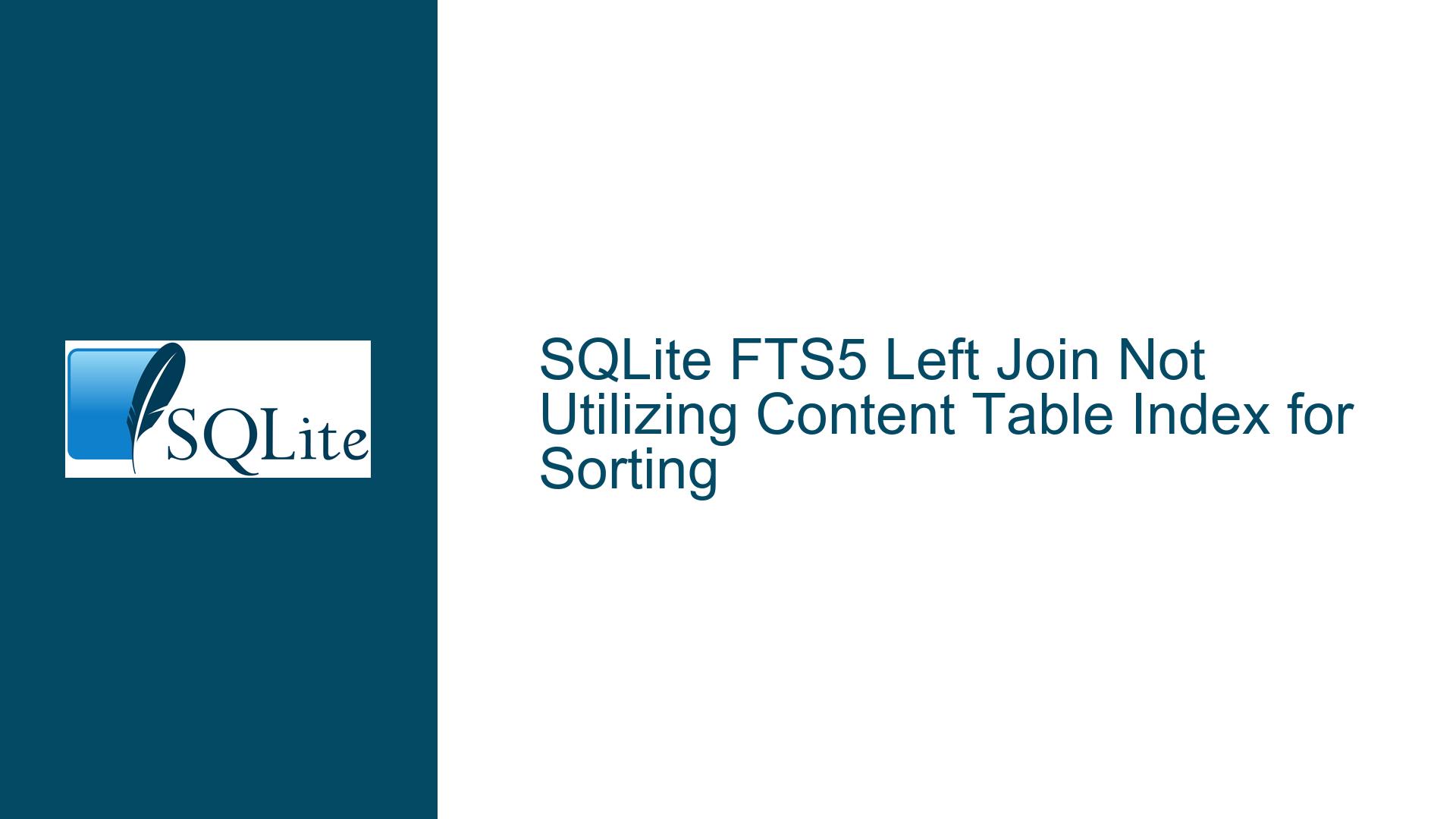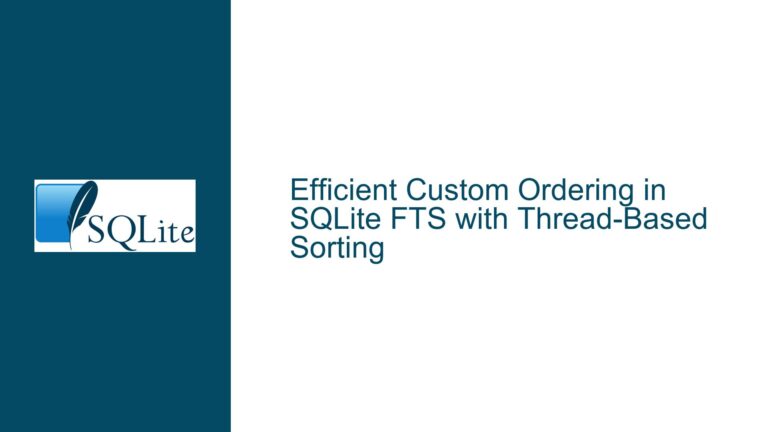SQLite FTS5 Left Join Not Utilizing Content Table Index for Sorting
Issue Overview: FTS5 Virtual Table Join and Order By Ignoring Content Table Index
The core issue revolves around SQLite’s query planner failing to utilize an existing index on a content table’s column when performing a LEFT JOIN with an FTS5 virtual table, followed by an ORDER BY operation on that indexed column. This manifests in suboptimal performance due to SQLite resorting to temporary B-tree structures for sorting rather than leveraging the pre-built index. The problem becomes pronounced when combining full-text search operations from FTS5 virtual tables with sorted results from traditional tables, particularly in scenarios involving:
- Virtual Table Limitations: FTS5’s specialized indexing mechanisms for text search don’t integrate seamlessly with traditional SQL indexes
- Query Execution Phases: The sequence of JOIN operations preceding ORDER BY creates fundamental constraints on index utilization
- Rowid Relationship Complexity: The content_rowid linkage between virtual and content tables introduces hidden execution plan considerations
At the schema level, we have a content table with standard indexes and an FTS5 virtual table configured with content synchronization. The query in question combines full-text matching from the virtual table with sorted results from the content table, creating a conflict between two optimization paths:
CREATE TABLE contentTable (
_id TEXT PRIMARY KEY,
sortFieldIndexed TEXT, -- Has separate index
ftsField TEXT
);
CREATE VIRTUAL TABLE virtualTable USING fts5(
_id UNINDEXED,
ftsField,
content=contentTable,
content_rowid='rowid'
);
The EXPLAIN QUERY PLAN output reveals critical path decisions:
|--SCAN virtualTable VIRTUAL TABLE INDEX 0:M2
|--SEARCH contentTable USING INTEGER PRIMARY KEY (rowid=?) LEFT-JOIN
--USE TEMP B-TREE FOR ORDER BY
This shows SQLite properly utilizing the rowid index for the JOIN but failing to employ the sortFieldIndexed index for ordering, instead building a temporary structure. Performance metrics demonstrate drastic differences: sub-1ms execution without sorting vs 30-40ms with ORDER BY, highlighting the index bypass.
Underlying Causes: FTS5 Join Mechanics and Query Planner Limitations
1. Virtual Table Indexing Constraints
FTS5 virtual tables maintain separate indexing structures optimized for text search operations (M2 index in the query plan). These indexes:
- Store tokenized content in inverted index format
- Optimize for MATCH operations rather than relational joins
- Lack statistics about correlated content table indexes
When joining virtualTable to contentTable via rowid, SQLite must:
- First resolve the FTS MATCH clause using FTS5’s internal index
- Then fetch corresponding contentTable rows by rowid
- Finally perform sorting on already-retrieved rows
This execution sequence prevents the query planner from considering index-based sorting during the initial retrieval phase.
2. Content Rowid Binding Priorities
The content_rowid=’rowid’ specification creates an implicit binding where:
- virtualTable.rowid directly maps to contentTable.rowid
- Forces use of contentTable’s rowid index for JOIN operations
- Establishes rowid as the primary retrieval mechanism
SQLite prioritizes this efficient rowid-based joining over potential sort optimizations, as altering the join sequence could jeopardize the FTS5 match results. The query planner makes a conscious trade-off: optimize JOIN speed at the cost of temporary sorting structures.
3. Query Phase Ordering Limitations
SQLite executes operations in strict sequence:
FTS MATCH → Content Table JOIN → Result Sorting
The sorting phase occurs after rows are materialized from both tables, making the contentTable.sortFieldIndexed index inaccessible for the following reasons:
- The sorted field exists in the outer table (contentTable)
- Indexed sorting requires pre-knowledge of sort order during row retrieval
- Post-retrieval sorting can’t utilize content table indexes
Additionally, the LEFT JOIN complicates matters by requiring preservation of virtualTable rows even with no contentTable match, making early sorting impossible.
4. Statistical Information Gaps
FTS5 virtual tables don’t provide standard statistical data to the query planner:
- No index cardinality information for joined columns
- Missing correlation statistics between virtual and content tables
- Inability to estimate sortFieldIndexed distribution from FTS5 side
This statistical void forces conservative planning decisions, favoring reliable rowid-based joins over potentially better sorted retrieval paths that can’t be cost-analyzed properly.
Resolution Strategies: Forcing Index Utilization and Query Restructuring
1. Materialized Subquery Approach
Bypass the join-order limitation by first materializing matching rowids, then joining with proper sort order:
WITH matched_rows AS (
SELECT rowid FROM virtualTable
WHERE virtualTable MATCH '"rig"*'
ORDER BY virtualTable.rowid DESC -- Force efficient FTS retrieval
LIMIT 20
)
SELECT c._id
FROM contentTable c
JOIN matched_rows m ON c.rowid = m.rowid
ORDER BY c.sortFieldIndexed;
This two-phase approach:
- Efficiently retrieves FTS matches using virtual table indexes
- Joins with contentTable in separate phase where sort index becomes usable
- Allows query planner to recognize sortFieldIndexed index availability
2. Index Hinting via CROSS JOIN
Force join order reversal using CROSS JOIN syntax:
SELECT c._id
FROM contentTable c
CROSS JOIN virtualTable v
WHERE v.rowid = c.rowid
AND v MATCH '"rig"*'
ORDER BY c.sortFieldIndexed
LIMIT 20;
The CROSS JOIN (equivalent to INNER JOIN but with join-order hinting) suggests to SQLite that contentTable should be the driving table. This enables:
- Content table index scan ordered by sortFieldIndexed
- Per-row FTS5 matches via rowid
- Early elimination of non-matching rows during index scan
3. Covered Index Optimization
Augment the sortFieldIndexed index to include both sorted field and rowid:
CREATE INDEX sort_index_covered ON contentTable(sortFieldIndexed, rowid);
This covering index allows:
- Full ORDER BY operation using the index
- Direct rowid retrieval without table access
- Elimination of temporary B-tree for sorting
Query becomes:
SELECT c._id
FROM virtualTable v
LEFT JOIN contentTable c ON v.rowid = c.rowid
WHERE v MATCH '"rig"*'
ORDER BY c.sortFieldIndexed
LIMIT 20;
The covering index satisfies both join and sort requirements through a single index structure.
4. Partial Index Filtering
When applicable filtering exists on sortFieldIndexed, create partial indexes:
CREATE INDEX sort_filtered ON contentTable(sortFieldIndexed)
WHERE sortFieldIndexed > 'A';
Combine with query predicates that match the partial index conditions to enable index-assisted sorting.
5. FTS5 Content Table Denormalization
Store sortFieldIndexed directly in the FTS5 table (with proper UNINDEXED designation):
CREATE VIRTUAL TABLE virtualTable USING fts5(
_id UNINDEXED,
ftsField,
sortFieldIndexed UNINDEXED,
content=contentTable,
content_rowid='rowid'
);
Then modify the query to sort using the denormalized field:
SELECT v._id
FROM virtualTable v
WHERE v MATCH '"rig"*'
ORDER BY v.sortFieldIndexed
LIMIT 20;
This approach:
- Keeps sorting within FTS5 virtual table context
- Avoids content table join entirely
- Requires maintaining denormalized copy of sortFieldIndexed
6. Query Planner Forcing Directives
Use SQLite-specific pragmas to influence planner decisions:
PRAGMA optimize;
PRAGMA analysis_limit=1000;
PRAGMA automatic_index=OFF;
SELECT c._id
FROM virtualTable v
LEFT JOIN contentTable c ON v.rowid = c.rowid
WHERE v MATCH '"rig"*'
ORDER BY c.sortFieldIndexed
LIMIT 20;
The PRAGMA optimize directive refreshes statistical data, while disabling automatic indexes prevents alternative plan generation.
7. Rowid Range Optimization
Leverage knowledge of rowid distributions to add range predicates:
SELECT c._id
FROM virtualTable v
LEFT JOIN contentTable c ON v.rowid = c.rowid
WHERE v MATCH '"rig"*'
AND c.rowid BETWEEN ? AND ?
ORDER BY c.sortFieldIndexed
LIMIT 20;
When combined with covering indexes, this allows range-based index scans that naturally produce sorted output.
8. Application-Side Sorting
For small result sets, retrieve unsorted rows then sort in application code:
-- SQL
SELECT c._id, c.sortFieldIndexed
FROM virtualTable v
LEFT JOIN contentTable c ON v.rowid = c.rowid
WHERE v MATCH '"rig"*'
LIMIT 20;
-- Application code
results.sort(key=lambda x: x['sortFieldIndexed'])
This bypasses SQLite’s sorting limitations entirely when dealing with few rows.
9. Shadow Table Materialization
Maintain a real table synchronized with FTS5 content:
CREATE TABLE virtualTable_shadow (
rowid INTEGER PRIMARY KEY,
_id TEXT,
ftsField TEXT,
sortFieldIndexed TEXT
);
-- Use triggers to keep in sync with contentTable
SELECT rowid, _id
FROM virtualTable_shadow
WHERE virtualTable_shadow MATCH '"rig"*' -- Using FTS5 auxiliary function
ORDER BY sortFieldIndexed
LIMIT 20;
Requires trigger maintenance but enables combined FTS and traditional indexing.
10. SQLite Version-Specific Optimizations
Upgrade to SQLite 3.42+ which includes enhanced query planner capabilities for:
- Better FTS5 join optimizations
- Improved covering index utilization
- Enhanced statistical analysis for virtual tables
Version-specific enhancements may resolve the issue without schema changes.
Each solution presents trade-offs between query complexity, maintenance overhead, and performance gains. Benchmarking with actual data distributions is crucial, as index efficacy heavily depends on data cardinality and value distributions in sortFieldIndexed. For critical deployments, combining covering indexes with query restructuring typically yields the most consistent performance improvements while maintaining schema integrity.






